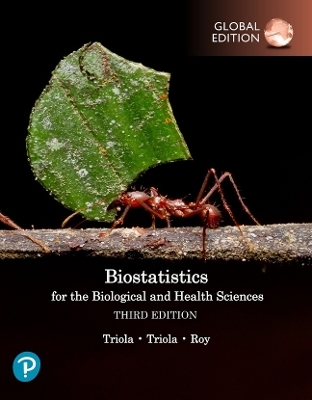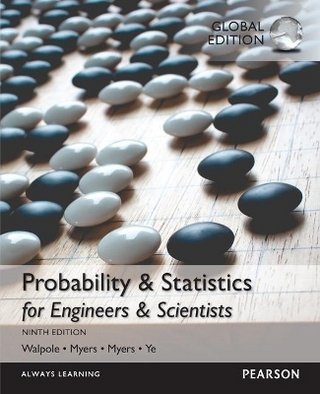
Statistics for Engineering and the Sciences Plus StatCrunch 12Month Access Card
Pearson Education Limited
978-1-4082-6639-7 (ISBN)
- Titel ist leider vergriffen;
keine Neuauflage - Artikel merken
This text is designed for a two-semester introductory course in statistics for students majoring in engineering or any of the physical sciences. Inevitalby, once these studenrts graduate and are employed, they will be involved in the collection and analysis of data and will be required to think critically about the results. Consequently, they need to acquire knowledge of the basic concepts of data description and statistical inference and familiarity with statistical methods they are required to use on the job.The text includes optional theoretical exercises allowing instructors who choose to emphasize theory to do so without requiring additional materials.
The assumed mathematical background is a two-semester sequence in calculus - that is, the course could be taught to students of average mathematical talent and with a basic understanding of the principles of differential and integral calculus.
CHAPTER 1: INTRODUCTION
1.1 Statistics: The Science of Data
1.2 Fundamental Elements of Statistics
1.3 Types of Data
1.4 The Role of Statistics in Critical Thinking
1.5 A Guide to Statistical Methods Presented in this Text
Statistics in Action: Contamination of Fish in the Tennessee River Collecting theData
CHAPTER 2: DESCRIPTIVE STATISTICS
2.1 Graphical and Numerical Methods for Describing Qualitative Data
2.2 Graphical Methods for Describing Quantitative Data
2.3 Numerical Methods for Describing Quantitative Data
2.4 Measures of Central Tendency
2.5 Measures of Variation
2.6 Measures of Relative Standing
2.7 Methods for Detecting Outliers
2.8 Distorting the Truth with Descriptive Statistics
Statistics in Action: Characteristics of Contaminated Fish in the Tennessee River
CHAPTER 3: PROBABILITY
3.1 The Role of Probability in Statistics
3.2 Events, Sample Spaces, and Probability
3.3 Compound Events
3.4 Complementary Events
3.5 Conditional Probability
3.6 Probability Rules for Unions and Intersections
3.7 Bayes' Rule (Optional)
3.8 Some Counting Rules
3.9 Probability and Statistics: An Example
3.10 Random Sampling
Statistics in Action: Assessing Predictors of Software Defects
CHAPTER 4: DISCRETE RANDOM VARIABLES
4.1 Discrete Random Variables
4.2 The Probability Distribution for a Discrete Random Variable
4.3 Expected Values for Random Variables
4.4 Some Useful Expectation Theorems
4.5 Bernoulli Trials
4.6 The Binomial Probability Distribution
4.7 The Multinomial Probability Distribution
4.8 The Negative Binomial and the Geometric Probability Distributions
4.9 The Hypergeometric Probability Distribution
4.10 The Poisson Probability Distribution
4.11 Moments and Moment Generating Functions (Optional)
Statistics in Action: The Reliability of a "One-Shot" Device
CHAPTER 5: CONTINUOUS RANDOM VARIABLES
5.1 Continuous Random Variables
5.2 The Density Function for a Continuous Random Variable
5.3 Expected Values for Continuous Random Variables
5.4 The Uniform Probability Distribution
5.5 The Normal Probability Distribution
5.6 Descriptive Methods for Assessing Normality
5.7 Gamma-Type Probability Distributions
5.8 The Weibull Probability Distriibution
5.9 Beta-Type Probability Distributions
5.10 Moments and Moment Generating Functions (Optional)
Statistics in Action: Super Weapons Development: Optimizing the Hit Ratio
CHAPTER 6: JOINT PROBABILITY DISTRIBUTIONS AND SAMPLING DISTRIBUTIONS
6.1 Bivariate Probability Distributions for Discrete Random Variables
6.2 Bivariate Probability Distributions for Continuous Random Variables
6.3 The Expected Value of Functions of Two Random Variables
6.4 Independence
6.5 The Covariance and Correlation of Two Random Variables
6.6 Probability Distributions and Expected Values of Functions of Random Variables (Optional)
6.7 Sampling Distributions
6.8 Approximating a Sampling Distribution by Monte Carlo Simulation
6.9 The Sampling Distributions of Means and Sums
6.10 Normal Approximation to the Binomial Distribution
6.11 Sampling Distributions Related to the Normal Distribution
Statistics in Action: Availability of an Up/Down System
CHAPTER 7: ESTIMATION USING CONFIDENCE INTERVALS
7.1 Point Estimators and their Properties
7.2 Finding Point Estimators: Classical Methods of Estimation
7.3 Finding Interval Estimators: The Pivotal Method
7.4 Estimation of Population Mean
7.5 Estimation of the Difference Between Two Population Means: Independent Samples
7.6 Estimation of the Difference Between Two Population Means: Matched Pairs
7.7 Estimation of a Poulation Proportion
7.8 Estimation of the Difference Between Two Population Proportions
7.9 Estimation of a Population Variance
7.10 Estimation of the Ratio of Two Population Variances
7.11 Choosing the Sample Size
7.12 Alternative Estimation Methods: Bootstrapping and Bayesian Methods (Optional)
Statistics in Action: Bursting Strength of PET Beverage Bottles
CHAPTER 8: TESTS OF HYPOTHESES
8.1 The Relationship Between Statistical Tests of Hypotheses and Confidence Intervals
8.2 Elements and Properties of a Statistical Test
8.3 Finding Statistical Tests: Classical Methods
8.4 Choosing the Null and Alternative Hypotheses
8.5 Testing a Population Mean
8.6 The Observed Significance Level for a Test
8.7 Testing the Difference Between Two Population Means: Independent Samples
8.8 Testing the Difference Between Two Population Means: Independent Samples
8.9 Testing a Population Proportion
8.10 Testing the Difference Between Two Population Proportions
8.11 Testing a Population Variance
8.12 Testing the Ration of Two Population Variances
8.13 Alternative Testing Procedures: Bootstrapping and Bayesian Methods (Optional)
Statistics in Action: Comparing Methods for Dissolving Drug Tablets - Dissolution Method Equivalence Testing
CHAPTER 9: CATEGORICAL DATA ANALYSIS
9.1 Categorical Data and Multinomial Probabilities
9.2 Estimating Category Probabilities in a One-Way Table
9.3 Testing Category Probabilities in a One-Way Table
9.4 Inferences About Category Probabilities in a Two-Way (Contingency) Table
9.5 Contingency Tables with Fixed Marginal Totals
9.6 Exact Tests for Independence in a Contingency Table Analysis (Optional)
Statistics in Action: The Public's Perception of Engineers and Engineering
CHAPTER 10: SIMPLE LINEAR REGRESSION
10.1 Regression Models
10.2 Model Assumptions
10.3 Estimating (R)0 and (R)1: The Method of Least Squares
10.4 Properties of the Least Squares Estimators
10.5 An Estimator of (TM)2
10.6 Assessing the Utility of the Model: Making Inferences About the Slope (R)1
10.7 The Coefficient of Correlation
10.8 The Coefficient of Determination
10.9 Using the Model for Estimation and Pediction
10.10 A Complete Example
10.11 A Summary of the Steps to Follow in Simple Linear Regression
Statistics in Action: Can Dowser's Really Detect Water?
CHAPTER 11: MULTIPLE REGRESSION ANALYSIS
11.1 General Form of a Multiple Regression Model
11.2 Model Assumptions
11.3 Fitting the Model: The Method of Least Squares
11.4 Computations using Matrix Algebra; Estimating and Making Inferences about the (R) Parameters
11.5 Assessing Overall Model Adequacy
11.6 A Confidence Interval for E(y) and a prediction interval for a Future Value of y
11.7 A First-Order Model with Quantitative Predictors
11.8 An Interaction Model with Quantitative Predictors
11.9 A Quadratic (Second-Order) Model with a Quantitative Predictor
11.10 Checking Assumptions: Residual Analysis
11.11 Some Pitfalls: Estimability, Multicollinearity, and Extrapolation
11.12 A Summary of the Steps to Follow in a Multiple Regression Analysis
Statistics in Action: Bid-Rigging in the Highway Construction Industry
CHAPTER 12: MODEL BUILDING
12.1 Introduction: Why Model Building is Important
12.2 The Two Types of Independent Variables: Quantitative and Qualitative
12.3 Models with a Single Quantitative Independent Variable
12.4 Models with Two Quantitative Independent Variables
12.5 Coding Quantitative Independent Variables (Optional)
12.6 Models with One Qualitative Independent Variable
12.7 Models with Both Quantitative and Qualitative Independent Variables
12.8 Tests for Comparing Nested Models
12.9 External Model Validation (Optional)
12.10 Stepwise Regression
Statistics in Action: Deregulation of the Intrastate Trucking Industry
CHAPTER 13: PRINCIPLES OF EXPERIMENTAL DESIGN
13.1 Introduction
13.2 Experimental Design Terminology
13.3 Controlling the Information in an Experiment
13.4 Noise-Reducing Designs
13.5 Volume-Increasing Designs
13.6 Selecting the Sample Size
13.7 The Importance of Randomization
Statistics in Action: Anti-Corrosive Behavior of Epoxy Coatings Augmented with Zinc
CHAPTER 14: ANALYSIS OF VARIANCE FOR DESIGNED EXPERIMENTS
14.1 Introduction
14.2 The Logic Behind an Analysis of Variance
14.3 One-Factor Completely Randomized Designs
14.4 Randomized Block Designs
14.5 Two-Factor Factorial Experiments
14.6 More Complex Factorial Designs (Optional)
14.7 Nested Sampling Designs (Optional)
14.8 Multiple Comparisons of Teatment Means
14.9 Checking ANOVA Assumptions
Statistics in Action: On the Trail of the Cockroach
CHAPTER 15: NONPARAMETRIC STATISTICS
15.1 Introduction: Distribution-Free Tests
15.2 Testing for Location of a Single Population
15.3 Comparing Two Populations: Independent Random Samples
15.4 Comparing Two Populations: Matched-Pair Design
15.5 Comparing Three or More Populations: Completely Randomized Design
15.6 Comparing Three or More Populations: Randomized Block Design
15.7 Nonparametric Regression
Statistics in Action: Agent Orange and Vietnam Vets
CHAPTER 16: STATISTICAL PROCESS AND QUALITY CONTROL
16.1 Total Quality Management
16.2 Variable Control Charts
16.3 Control Chart for Means: x-Chart
16.4 Control Chart for Process Variation: R-Chart
16.5 Detecting Trends in a Control Chart: Runs Analysis
16.6 Control Chart for Percent Defective: p-Chart
16.7 Control Chart for number of Defectives per item: c-Chart
16.8 Tolerance Limits
16.9 Capability Analysis (Optional)
16.10 Acceptance Sampling for Defectives
16.11 Other Sampling Plans (Optional)
16.12 Evolutionary Operations (Optional)
Statistics in Action: Testing Jet Fuel Additive for Safety
CHAPTER 17: PRODUCT AND SYSTEM RELIABILITY
17.1 Introduction
17.2 Failure Time Distributions
17.3 Hazard Rates
17.4 Life Testing: Censored Sampling
17.5 Estimating the Parameters of an Exponential Failure Time Distribution
17.6 Estimating the Parameters of a Weibull Failure Time Distribution
17.7 System Reliability
Statistics in Action: Modeling the Hazard Rate of Reinforced Concrete Bridge Deck Deterioration
APPENDIX A: MATRIX ALGEBRA
APPENDIX B: USEFUL STATISTICAL TABLES
APPENDIX C: SAS FOR WINDOWS TUTORIAL
APPENDIX D: MINITAB FOR WINDOWS TUTORIAL
APPENDIX E: SPSS FOR WINDOWS TUTORIAL
ANSWERS TO SELECTED EXERCISES
INDEX
| Erscheint lt. Verlag | 15.7.2010 |
|---|---|
| Verlagsort | Harlow |
| Sprache | englisch |
| Maße | 260 x 214 mm |
| Gewicht | 2160 g |
| Themenwelt | Mathematik / Informatik ► Mathematik ► Statistik |
| Technik ► Elektrotechnik / Energietechnik | |
| Technik ► Maschinenbau | |
| ISBN-10 | 1-4082-6639-3 / 1408266393 |
| ISBN-13 | 978-1-4082-6639-7 / 9781408266397 |
| Zustand | Neuware |
| Haben Sie eine Frage zum Produkt? |
aus dem Bereich

